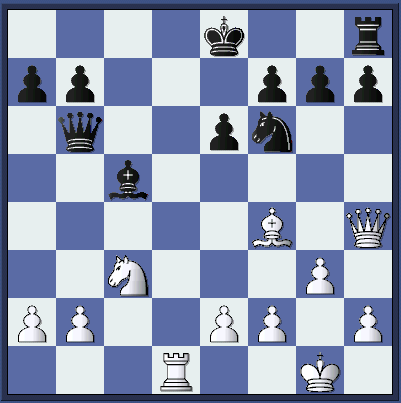All
the |
(Navigation bar
directly below.)
*******
© A.J. Goldsby, 2015.
(All rights reserved.)
****************
Click HERE
to see my
Chess Items.
****************
****************
Buy a book
from Amazon.com
(And help me out as well!)
****************
Click HERE
...
to see a list of the businesses that help to sponsor all of
my chess efforts.
|
|
|---|
This is game # 6 of my Tactical School.
It is a training game played against one of my (Internet) students. (A Catalan Opening, of all things.)
***
This is the sixth game of my tactical school. The more you study and go over this game, the more you will begin to be able to understand and use the ideas. I advise repeated study. This game could be studied 2-3 hours, (at one time); in a tactical vein. It could also be studied for 30-90 minutes at a time during your penings study. (See the parent page for details.)
Here the KEY POSITION is VERY complex. A chess set and board are required. I advise that you set up the key position and study it 30-45 minutes, (without moving any pieces); and possibly even write down what you analyzed. Then take at least 2-3 hours and play through a few of the continuations. Don't study just the moves, try to understand the REASON for the move. The more you study like this, the more you will improve.
There is a brief opening survey included. It is NOT meant to be comprehensive!! But it should give the average player a good idea of the state of the theory of this line. (I looked at dozens of games and MANY different books to assemble this.) {Different books give different move orders for the Catalan.}
I STRONGLY advise that you study the plain, un-annotated version(s) of this game, (Click HERE.); before you even look at the annotated version of this game. (See the parent page for details.)
A.
J. Goldsby (2250) - John Anderson (1600)
|
|
|
17.Bg5!,
(Maybe - '!!') {Diagram?}
This is very, very sharp,
but is it all really sound?
(Apparently it is.)
--->
Note: June, 2005. I ran this game by both
Shredder and ChessMaster 10th edition
a few weeks
ago. Apparently both machines find 17.Bh6!!, which is probably a little
superior to
the move actually played in the game.
*****
[ Another alternative is: </= 17.e3!? 0-0; Probably the safest move.
(Probably too
risky is: 17...Qxb2?!; 18.Be5, "--->" {Diagram?}
White has an
attack/initiative, that is very dangerous for the
second player here.)
18.b3, "=" The position is very balanced.
***
Interesting was: 17.Na4!?
Bxf2+; 18.Kg2 Qb5; 19.Kxf2 Qxa4;
20.Rd8+! Kxd8;
21.Bc7+ Kxc7; 22.Qxa4,
"+/="
White is clearly a bit better in this position.
]
*****
17...Be7;
Black chooses a "safety first" option here.
[ Black runs
into serious trouble after taking on f2:
17...Bxf2+?!;
(Maybe - '?') {Diagram?}
Much
too risky.
18.Kf1!,
Probably the best move.
(Also good for
White is: 18.Kg2 Bc5; 19.Bxf6 gxf6;
20.Ne4, "+/=" {Diagram?} with a fairly sizable advantage
for the first player here.)
18...Bg1!?;
This was the threat that really concerned me the most.
(Black also loses after: 18...Bc5; 19.Bxf6 gxf6; 20.Qxf6
0-0;
21.Na4 Qc6; 22.Qg5+ Kh8; 23.Qxc5 Qh1+; 24.Qg1, "+/-")
19.Qa4+ Kf8; 20.e3! h6;
This is just about forced.
*******
( But not 20...Qxb2?; 21.Rd8+ Ke7; 22.Qd7#!
Also bad for Black is: </= 20...Bx33?; 21.Bxe3 Qxe3;
22.Qb4+ Ke8; 23.QxP/b7, ("+/-") with an easily won game. )
*******
21.Qa3+ Kg8; 22.Rd6 Qc7; 23.Bxf6 gxf6;
24.Kxg1,
"+/-" with a won game. (For
White.)
***
Even worse is the capture on the b2-square.
For example:
17...Qxb2?; 18.Bxf6 gxf6; 19.Qxf6,
White threatens a mate on d8.
His Queen guards c3, and he threatens
the Rook on h8. If Black castles, simply
Qg5+; picking off the Bishop
on c5.
(19.Qa4+!?)
19...Bxf2+; This is pretty much forced.
20.Kxf2 0-0; 21.Rd4, "+/-" and Black can resign. ]
*****
GO OVER THE ABOVE VARIATIONS MANY TIMES. STUDY THEM VERY
CAREFULLY. THEY
ARE THE WHOLE REASON THAT I STARTED
THE TACTICAL
SCHOOL IN THE FIRST PLACE!
18.Qa4+ Kf8;
19.b3!?, "+/=" {Diagram?}
A simple move that
gives White a small advantage.
[ Much better was: >= 19.Qc4! Qc6;
20.Qf4, "+/="
with a considerable edge. ]
Now Black feels he is forced into giving up an
exchange.
(The rest really needs no comment.)
19...h6; 20.Be3 Bc5; 21.Bxc5+ Qxc5; 22.Rd8+ Ke7;
23.Rxh8 Qxc3; 24.Qxa7!?,
This is OK ... but maybe even better was the move, Qa3+.
[ An improvement was:
>/= 24.Qa3+! Kd7; 25.Rf8,
"+/-"
and Black falls apart. ]
24...Qe1+;
25.Kg2
Qxe2; 26.Qxb7+,
I saw Qc5+, but I was growing a little
short of time.
I was also already feeling fatigued, from the calculating effort
of the earlier mountain of complications.
[ White wins simply after:
>/= 26.Qc5+! Kd7; 27.Qc8+ Kd6;
28.Rd8+ Ke5;
29.Qc5+! Nd5; This is forced.
(29...Ke4??; 30.Rd4#)
30.Rxd5+!, ("+/-")
and now
if Black captures the Rook, White wins Black's
Queen with the skewer attack of Qe7+.
(This is the tactic I actually missed during the game!)
(I.e., 30.Rxd5+! exd5; 31.Qe7+ Kd4; 32.Qxe2, "+/-") ]
26...Nd7;
27.Ra8!?,
This is nice, but it might have been much easier to simply push
the QRP up the board.
[ >/= 27.a4, "+/-" ]
27...Kf6; 28.Qf3+, ("+/-") Black Resigns.
(With the Queens off, his game is hopeless. Plus he was nearly out of time.)
Copyright (c) A.J. Goldsby I.
[ But definitely not: 28.Qxd7?? Qe4+;
29.f3 Qxa8; "<=>" {Diagram?}
with some drawing chances for Black in the Q+P ending.
]
(Analysis initially) Generated with ChessBase 8.0
1 - 0
(Page posted in January. Last update: 06/22/05. Last edit on: 04/14/2014 .)
Click HERE to return to my home page.
Copyright (c) A.J. Goldsby I
Copyright (©) A.J. Goldsby, 1985-2013.
Copyright (©) A.J. Goldsby, 2014. All rights reserved.

